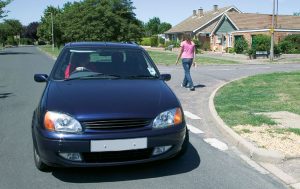 You are allowed to reverse as far as necessary but no further. This is because what is necessary will vary on different roads. For example, on single-track lanes, you may need to reverse a long way to find a suitable passing point. You are also permitted to reverse in order to turn your vehicle around. However, you should proceed with extra caution when doing so. Carefully look all around you and look out for pedestrians. Even if you have reversing aids such as camera systems and sensors, you still need to carry out your usual checks. You should also never reverse from a side road out on to a main road as this could be very dangerous.
You are allowed to reverse as far as necessary but no further. This is because what is necessary will vary on different roads. For example, on single-track lanes, you may need to reverse a long way to find a suitable passing point. You are also permitted to reverse in order to turn your vehicle around. However, you should proceed with extra caution when doing so. Carefully look all around you and look out for pedestrians. Even if you have reversing aids such as camera systems and sensors, you still need to carry out your usual checks. You should also never reverse from a side road out on to a main road as this could be very dangerous.
Why shouldn’t you reverse further than is necessary?
There are numerous reasons why you should not reverse your vehicle any further than necessary. Reasons include, but are not restricted to, the following examples:
- It is more difficult to see the way you are going
- It is easier to put yourself into difficulties because your steering has a greater effect
- It is harder to see potential hazards
- You will potentially be moving towards approaching traffic
Theory Test Question
So, have you answered the theory test question: Over what distance are you allowed to reverse? Let’s take each answer in turn and check your understanding:
As far as it takes to reverse around a corner
Wrong! You should only reverse as far as you need to. If you need to turn around, this can be done safely using an opening and does not require you to reverse as far as the nearest corner.
The length of a residential street
Wrong! Residential streets will vary in length which would make this a difficult rule to follow. When reversing, you should only go as far as is necessary and no further.
No more than a car’s length
Wrong! Sometimes you may need to reverse further than a car’s length, such as on a single track lane where you need to find a passing point. As such, you are permitted to reverse as far as you need but no further.
No further than is necessary
Correct! You can reverse as far as you need to. However, it is important to stress that you should not reverse for longer than necessary due to the additional risks associated with reversing.
References
In section 9 of the official DVSA guide to driving, it states:
All-round observation is just as important when you’re reversing as it is when you’re going forward.
- Check for other road users before you reverse; motorcycles, cyclists and pedestrians are more difficult to see.
- Check to the rear, particularly for children playing behind the vehicle.
- Check all round – forward, behind, over both shoulders and in all mirrors. Do this before you reverse.
- If in doubt, get out and check.
- Keep checking all the time you’re moving backwards, particularly behind you and to the sides, and especially at the point of turning.
Always be ready to stop.
Remember also
- never to reverse into a main road from a side road
- to make sure it’s safe to reverse, even if that means getting help
- not to reverse for a long distance, for your own safety and for that of other people. It’s an offence to reverse further than necessary
- to always be ready to give way and stop.
Rule 203 of the Highway Code states:
You MUST NOT reverse your vehicle further than necessary.
Law CUR reg 106


